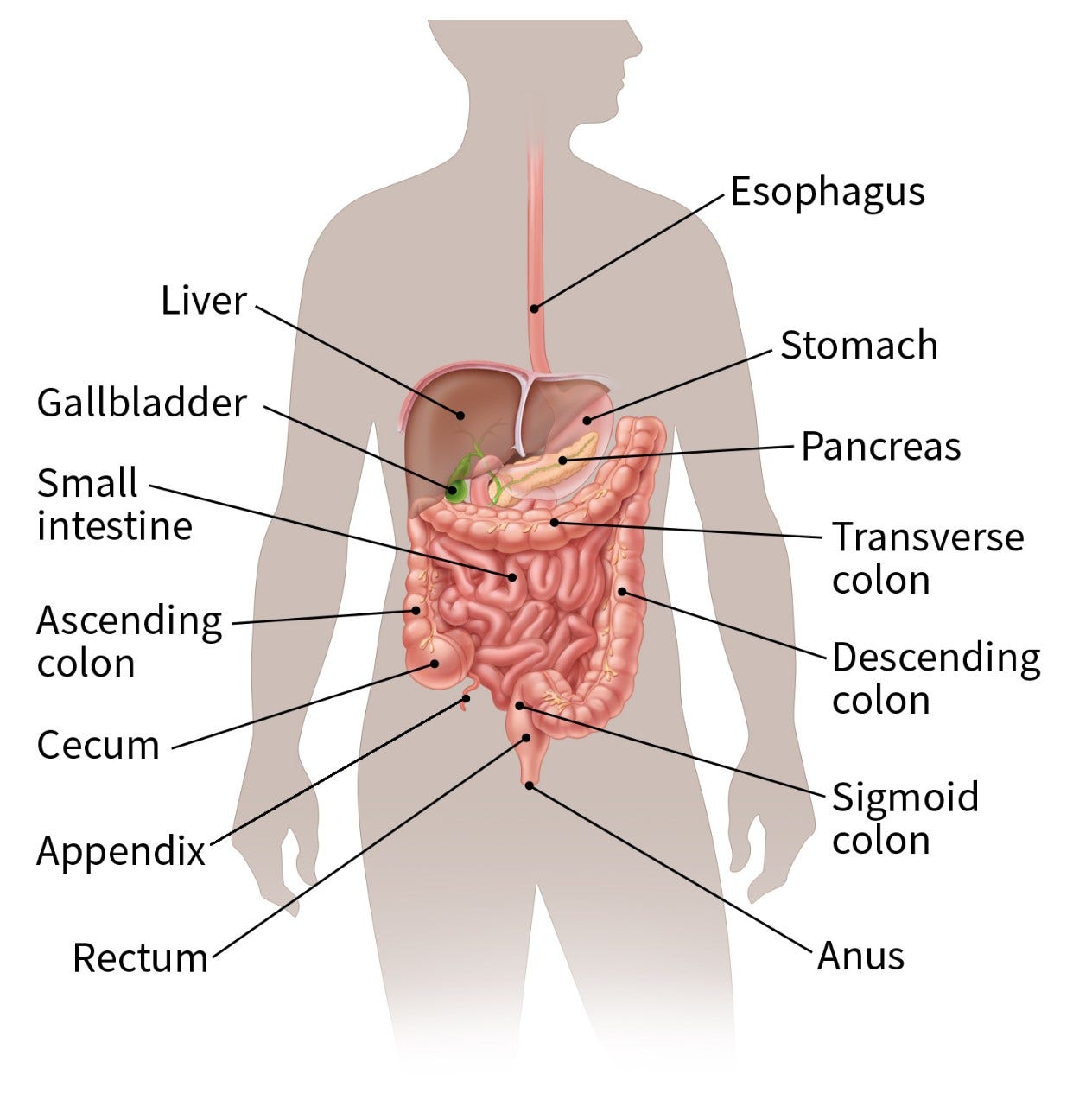Your gift is 100% tax deductible
What Is a Gastrointestinal Neuroendocrine Tumor?
Gastrointestinal neuroendocrine cancers (referred to in the past as carcinoid tumors) develop in the digestive or gastrointestinal (GI) tract. They start in specialized cells of the body’s neuroendocrine system. This is why these tumors are also called neuroendocrine tumors (NET). To understand gastrointestinal neuroendocrine tumors, it helps to know about the gastrointestinal system, as well as the neuroendocrine system.
The gastrointestinal system
The gastrointestinal (GI) system, also known as the digestive system, processes food for energy and rids the body of solid waste. After food is chewed and swallowed, it enters the esophagus. This tube carries food through the neck and chest to the stomach. The esophagus joins the stomach just beneath the diaphragm (the breathing muscle under the lungs). The stomach is a sac that holds food and begins the digestive process by secreting gastric juice. The food and gastric juices are mixed into a thick fluid, which then empties into the small intestine.

The small intestine keeps breaking down food and absorbs most of the nutrients. It is the longest section of the gastrointestinal (GI) tract, measuring more than 20 feet (6 meters). The small intestine then joins the colon. This is a wider, muscular tube about 5 feet (1.5 meters) long. The appendix is near the junction of small intestine and colon. The colon absorbs water, minerals, and nutrients from food and serves as a storage place for waste. The waste that is left after this process goes into the rectum. From there it leaves the body through the anus as stool (feces).
The neuroendocrine system
The neuroendocrine system has cells that act like nerve cells in certain ways and like hormone-making endocrine cells in others. These cells don’t form an actual organ like the adrenal or thyroid glands. Instead, they are scattered throughout organs like the esophagus, stomach, pancreas, intestines, appendix, and lungs. The digestive system has more neuroendocrine cells than any other part of the body. This might be why neuroendocrine tumors most often start there.
Neuroendocrine cells help control the release of digestive juices and how fast food moves in the GI tract. They may also help control the growth of other types of digestive system cells. Like most cells in the body, GI tract neuroendocrine cells sometimes go through certain changes that cause them to grow too much and form cancers. These cancers as a group are called neuroendocrine tumors.
Neuroendocrine tumors
Neuroendocrine tumors (NETs)most commonly develop in the GI tract. NETs are often slow growing, but some are not and can possibly spread to other parts of the body.
They are classified by tumor grade which describes how quickly the cancer is likely to grow and spread.
- Grade 1 (low grade) NETs have cells that look more like normal cells and are not multiplying quickly.
- Grade 2 (intermediate grade) NETs have features in between those of low- and high-grade tumors.
- Grade 3 (high grade) NETs have cells that look very abnormal and are multiplying faster. (well or poorly differentiated with high multiplication index).
Cancers that are grade 1 or grade 2 are called well-differentiated GI neuroendocrine tumors. These cancers tend to grow slowly and can possibly spread to other parts of the body.
Cancers that are grade 3 can be well differentiated (neuroendocrine tumors) or poorly differentiated (neuroendocrine carcinomas, NECs). These cancers tend to grow and can spread quickly to other parts of the body.
Other gastrointestinal tumors
Pancreatic neuroendocrine tumors have a different prognosis (course of disease and outlook) and respond differently to treatment. Neuroendocrine tumors of the pancreas are not covered here (see Pancreatic Neuroendocrine Tumors).
It is important to know what type of tumor you have. Information about other tumors of the GI tract can be found in Esophagus Cancer, Stomach Cancer, Small Intestine Cancer, and Colorectal Cancer.
- Written by
- References

Developed by the American Cancer Society medical and editorial content team with medical review and contribution by the American Society of Clinical Oncology (ASCO).
Akerström G, Stålberg P, Wängberg B, et al. Neuroendocrine tumors: Current trends in diagnosis and therapy. J Oncol. 2021;2021:1-10. doi: 10.1155/2021/8844243.
Bosman F. WHO classification of tumours of the digestive system. 4th ed. Lyon: International Agency for Research on Cancer; 2010.
Kim JY, Hong SM, Ro JY. Recent updates on grading and classification of neuroendocrine tumors. Ann Diagn Pathol. 2017;29:11-6. doi: 10.1016/j.anndiagpath.2017.04.005.
Modlin IM, Lye KD, Kidd M. A 5-decade analysis of neuroendocrine tumor epidemiology: Is there a recent explosion of neuroendocrine tumors? Cancer. 2021;127(1):2-11. doi: 10.1002/cncr.33063.
Norton JA, Kunz PL. Carcinoid tumors and the carcinoid syndrome. In: DeVita VT, Hellman S, Rosenberg SA, editors. Cancer: Principles and Practice of Oncology. 10th ed. Philadelphia, PA: Lippincott Williams & Wilkins; 2015. p. 1218-26.
Oronsky B, Ma PC, Morgensztern D, Carter CA. Nothing but NET: A review of neuroendocrine tumors and carcinomas. Neoplasia. 2017;19(12):991-1002. doi: 10.1016/j.neo.2017.09.002.
Schneider DF, Mazeh H, Lubner SJ, Jaume JC, Chen H. Cancer of the endocrine system. In: Niederhuber JE, Armitage JO, Doroshow JH, Kastan MB, Tepper JE, editors. Abeloff's Clinical Oncology. 5th ed. Philadelphia, PA: Elsevier; 2014. p. 1112-42.
Yao JC, Hassan M, Phan A, et al. One hundred years after "carcinoid": The evolving diagnosis and management of neuroendocrine tumors. J Clin Oncol. 2020;38(30):3629-41. doi: 10.1200/JCO.20.02133.
Last Revised: August 8, 2025
American Cancer Society medical information is copyrighted material. For reprint requests, please see our Content Usage Policy.
American Cancer Society Emails
Sign up to stay up-to-date with news, valuable information, and ways to get involved with the American Cancer Society.



